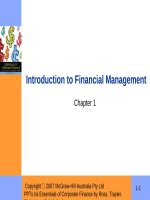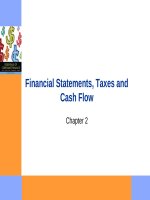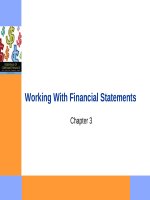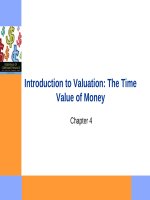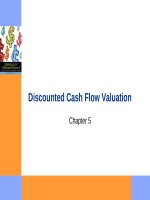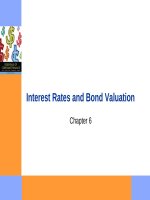Lecture Essentials of corporate finance (2/e) – Chapter 13: Leverage and capital structure
Bạn đang xem bản rút gọn của tài liệu. Xem và tải ngay bản đầy đủ của tài liệu tại đây (597.82 KB, 46 trang )
Leverage and capital
structure
Chapter 13
Key concepts and skills
• Understand the effect of financial
leverage on cash flows and cost of
equity
• Understand the impact of taxes and
bankruptcy on capital structure choice
• Understand the basic components of
bankruptcy
Copyright © 2011 McGraw-Hill Australia Pty Ltd
PPTs t/a Essentials of Corporate Finance 2e by Ross et al.
Slides prepared by David E. Allen and Abhay K. Singh
13-2
Chapter outline
• The capital structure question
• The effect of financial leverage
• Capital structure and the cost of equity
capital
• Corporate taxes and capital structure
• Bankruptcy costs
• Optimal capital structure
• Observed capital structures
• A quick look at the bankruptcy process
Copyright © 2011 McGraw-Hill Australia Pty Ltd
PPTs t/a Essentials of Corporate Finance 2e by Ross et al.
Slides prepared by David E. Allen and Abhay K. Singh
13-3
Capital structure
• Capital structure—percentage of debt
and equity used to fund the firm’s
assets
– ‘Leverage’ = use of debt in capital
structure
• Capital restructuring—changing the
amount of leverage without changing
the firm’s assets
– Increase leverage by issuing debt and
repurchasing outstanding shares
– Decrease leverage by issuing new shares
Copyright
© 2011
McGraw-Hill outstanding
Australia Pty Ltd
and
retiring
debt
PPTs t/a Essentials of Corporate Finance 2e by Ross et al.
Slides prepared by David E. Allen and Abhay K. Singh
13-4
Capital structure and
shareholder wealth
• What is the primary goal of financial
managers?
– To maximise shareholder wealth
• We want to choose the capital structure
that will maximise shareholder wealth.
• We can maximise shareholder wealth
by maximising firm value or minimising
WACC.
Copyright © 2011 McGraw-Hill Australia Pty Ltd
PPTs t/a Essentials of Corporate Finance 2e by Ross et al.
Slides prepared by David E. Allen and Abhay K. Singh
13-5
The effect of financial
leverage
• How does leverage affect the earnings per
share (EPS) and return on equity (ROE) of a
firm?
• When we increase the amount of debt
financing, we increase the fixed interest
expense.
• If we have a really good year, we pay our fixed
costs and we have more left over for our
shareholders.
• If we have a really bad year, we still have to
pay our fixed costs and we have less left over
for our shareholders.
• Leverage
amplifies the variation in both EPS
Copyright © 2011 McGraw-Hill Australia Pty Ltd
PPTs t/a ROE.
Essentials of Corporate Finance 2e by Ross et al.
13-6
and
Slides prepared by David E. Allen and Abhay K. Singh
Financial leverage, EPS and
ROE example—Table 13.1
•
•
•
We will ignore the effect of taxes at this stage.
What happens to EPS and ROE when we issue debt and buy
back shares?
Eagles Air Services
Table 13.1
Assets
Debt
Equity
Debt/Equity Ratio
Share Price
Shares Outstanding
Interest rate
Current
$8,000,000
$0
$8,000,000
0.0
$20
400,000
10%
Copyright © 2011 McGraw-Hill Australia Pty Ltd
PPTs t/a Essentials of Corporate Finance 2e by Ross et al.
Slides prepared by David E. Allen and Abhay K. Singh
Proposed
$8,000,000
$4,000,000
$4,000,000
1.0
$20
200,000
10%
13-7
Eagles Air Services
Capital structure scenarios—Table
13.2
Table 13.2
EBIT
Interest
Net Income
ROE
EPS
Current Capital Structure: No Debt
Recession
Expected
Expansion
$500,000
$1,000,000
$1,500,000
0
0
0
$500,000
$1,000,000
$1,500,000
6.25%
12.50%
18.75%
$1.25
$2.50
$3.75
Proposed Capital Structure: Debt = $4 million
Recession
Expected
Expansion
EBIT
$500,000
$1,000,000
$1,500,000
Interest
400,000
400,000
400,000
Net Income
$100,000
$600,000
$1,100,000
ROE
2.50%
15.00%
27.50%
EPS
$0.50
$3.00
$5.50
Copyright © 2011 McGraw-Hill Australia Pty Ltd
PPTs t/a Essentials of Corporate Finance 2e by Ross et al.
Slides prepared by David E. Allen and Abhay K. Singh
13-8
Financial leverage, EPS and
ROE—Example
• Variability in ROE
– Current: ROE ranges from 6.25% to
18.75%
– Proposed: ROE ranges from 2.50% to
27.50%
• Variability in EPS
– Current: EPS ranges from $1.25 to $3.75
– Proposed: EPS ranges from $0.50 to
$5.50
• The variability in both ROE and EPS
increases when financial leverage is
Copyright © 2011 McGraw-Hill Australia Pty Ltd
PPTs t/a Essentials of Corporate Finance 2e by Ross et al.
Slides prepared by David E. Allen and Abhay K. Singh
13-9
Break-even EBIT
• Find EBIT where EPS is the same
under both the current and proposed
capital structures.
• If we expect EBIT to be greater than
the break-even point, then leverage is
beneficial to our shareholders.
• If we expect EBIT to be less than the
break-even point, then leverage is
detrimental to our shareholders.
Copyright © 2011 McGraw-Hill Australia Pty Ltd
PPTs t/a Essentials of Corporate Finance 2e by Ross et al.
Slides prepared by David E. Allen and Abhay K. Singh
13-10
Break-even EBIT—Example
EPS = for both capital structures
EBIT
400,000
EBIT
EBIT
EBIT
EPS
EBIT 400,000
200,000
400,000
200,000
EBIT
400,000
2 EBIT 800,000
$800,000
800,000
$2.00
400,000
Copyright © 2011 McGraw-Hill Australia Pty Ltd
PPTs t/a Essentials of Corporate Finance 2e by Ross et al.
Slides prepared by David E. Allen and Abhay K. Singh
13-11
Break-even EBIT (cont.)
• If we expect EBIT to be greater than the break-even
point, then leverage is beneficial to our stockholders.
• If we expect EBIT to be less than the break-even point,
Copyright
© 2011 McGraw-Hill
Australia Pty Ltdto our stockholders.
then
leverage
is
detrimental
PPTs t/a Essentials of Corporate Finance 2e by Ross et al.
Slides prepared by David E. Allen and Abhay K. Singh
13-12
Eagle Air Services—
Conclusion
he effect of leverage depends on EBIT:
When EBIT is higher, leverage is beneficial.
nder the ‘expected’ scenario, leverage
increases ROE and EPS.
hareholders are exposed to more risk
with more leverage.
ROE and EPS more sensitive to changes in
EBIT.
Copyright © 2011 McGraw-Hill Australia Pty Ltd
PPTs t/a Essentials of Corporate Finance 2e by Ross et al.
Slides prepared by David E. Allen and Abhay K. Singh
. Capital structure is an important
13-13
Homemade leverage and ROE
—Example
•
Homemade leverage
– The use of personal borrowing to change the overall amount of
financial leverage to which the individual is exposed.
Conclusion:
• Any stockholder who prefers leverage can create their own
‘homemade’ leverage and replicate the payoffs.
• Eagle Air Services’ capital structure is irrelevant to
shareholders.
Copyright © 2011 McGraw-Hill Australia Pty Ltd
PPTs t/a Essentials of Corporate Finance 2e by Ross et al.
Slides prepared by David E. Allen and Abhay K. Singh
13-14
Capital structure theory
• Modigliani and Miller
– M&M Proposition I—The pie model
– M&M Proposition II—WACC
• The value of the firm is determined by the
cash flows to the firm and the risk of the
firm’s assets.
• Changing firm value
– Change the risk of the cash flows
– Change the cash flows
Copyright © 2011 McGraw-Hill Australia Pty Ltd
PPTs t/a Essentials of Corporate Finance 2e by Ross et al.
Slides prepared by David E. Allen and Abhay K. Singh
13-15
Capital structure theory
Three special cases
• Case I—Assumptions
– No corporate or personal taxes
– No bankruptcy costs
• Case II—Assumptions
– Corporate taxes, but no personal taxes
– No bankruptcy costs
• Case III—Assumptions
– Corporate taxes, but no personal taxes
– Bankruptcy costs
Copyright © 2011 McGraw-Hill Australia Pty Ltd
PPTs t/a Essentials of Corporate Finance 2e by Ross et al.
Slides prepared by David E. Allen and Abhay K. Singh
13-16
Case I—Propositions I and
II
• Proposition I
– The value of the firm is NOT affected by
changes in the capital structure.
– The cash flows of the firm do not change;
therefore value doesn’t change.
• Proposition II
– The WACC of the firm is NOT affected by
capital structure.
Copyright © 2011 McGraw-Hill Australia Pty Ltd
PPTs t/a Essentials of Corporate Finance 2e by Ross et al.
Slides prepared by David E. Allen and Abhay K. Singh
13-17
Case I—Equations
• WACC = RA = (E/V)RE + (D/V)RD
• RE = RA + (RA – RD)(D/E)
– RA is the ‘cost’ of the firm’s business risk,
i.e. the risk of the firm’s assets.
– (RA – RD)(D/E) is the ‘cost’ of the firm’s
financial risk, i.e. the additional return
required by stockholders to compensate
for the risk of leverage.
Copyright © 2011 McGraw-Hill Australia Pty Ltd
PPTs t/a Essentials of Corporate Finance 2e by Ross et al.
Slides prepared by David E. Allen and Abhay K. Singh
13-18
Case I—Example
•
•
•
•
Data
– Required return on assets = 16%, cost of debt = 10%,
percentage of debt = 45%
What is the cost of equity?
– RE = .16 + (.16 - .10)(.45/.55) = .2091 = 20.91%
Suppose instead that the cost of equity is 25%, what is the
debt-to-equity ratio?
– .25 = .16 + (.16 - .10)(D/E)
– D/E = (.25 - .16) / (.16 - .10) = 1.5
Based on this information, what is the percentage of equity in
the firm?
– E/V = 1 / 2.5 = 40%
Copyright © 2011 McGraw-Hill Australia Pty Ltd
PPTs t/a Essentials of Corporate Finance 2e by Ross et al.
Slides prepared by David E. Allen and Abhay K. Singh
13-19
M&M Propositions I and II
Figure 13.3
• The change in the capital structure weights (E/V and D/V)
is exactly offset by the change in the cost of equity (RE),
so the WACC stays the same.
Copyright © 2011 McGraw-Hill Australia Pty Ltd
PPTs t/a Essentials of Corporate Finance 2e by Ross et al.
Slides prepared by David E. Allen and Abhay K. Singh
13-20
The CAPM, the SML and
Proposition II
• How does financial leverage affect
systematic risk?
• CAPM: RA = Rf + A(RM – Rf)
– Where A is the firm’s asset beta and
measures the systematic risk of the firm’s
assets.
• Proposition II
– Replace RA with the CAPM and assume that
the debt is riskless (RD = Rf).
–R =R +
(1+D/E)(R – Rf)
Copyright © 2011 McGraw-Hill Australia Pty Ltd
PPTs t/aE
Essentialsf of Corporate
Finance 2e by Ross
A
M et al.
Slides prepared by David E. Allen and Abhay K. Singh
13-21
Business risk and financial
risk
• RE = R f +
A
(1+D/E)(RM – Rf)
• CAPM: RE = Rf +
–
E
=
A
E
(RM – Rf)
(1 + D/E)
• Therefore, the systematic risk of the
share depends on:
– Systematic risk of the assets, A (business
risk)
– Level of leverage, D/E (financial risk)
Copyright © 2011 McGraw-Hill Australia Pty Ltd
PPTs t/a Essentials of Corporate Finance 2e by Ross et al.
Slides prepared by David E. Allen and Abhay K. Singh
13-22
Case II—Corporate taxes
• Interest on debt is tax deductible.
• When a firm adds debt, it reduces
taxes, all else being equal.
• The reduction in taxes increases the
cash flow of the firm.
• The reduction in taxes reduces net
income.
Copyright © 2011 McGraw-Hill Australia Pty Ltd
PPTs t/a Essentials of Corporate Finance 2e by Ross et al.
Slides prepared by David E. Allen and Abhay K. Singh
13-23
Case II—Example
Unlevered firm
Levered firm
5000
5000
0
500
Taxable Income
5000
4500
Taxes (30%)
1500
1350
Net Income
3500
3150
CFFA
3500
3650
EBIT
Interest
Copyright © 2011 McGraw-Hill Australia Pty Ltd
PPTs t/a Essentials of Corporate Finance 2e by Ross et al.
Slides prepared by David E. Allen and Abhay K. Singh
13-24
Interest tax shield
• Annual interest tax shield
– Tax rate times interest payment
– 6250 in 8% debt = 500 in interest expense
– Annual tax shield = .30(500) = 150
• Present value of annual interest tax
shield
– Assume perpetual debt for sake of
simplicity
– PV = 150 / .08 = 1875
Copyright © 2011 McGraw-Hill Australia Pty Ltd
PPTs t/a Essentials of Corporate Finance 2e by Ross et al.
= byD(R
DTC = 6250(.30) =
Slides
prepared
David E. )(T
Abhay K.
– PV
D Allen and
C)/R
D =Singh
13-25




